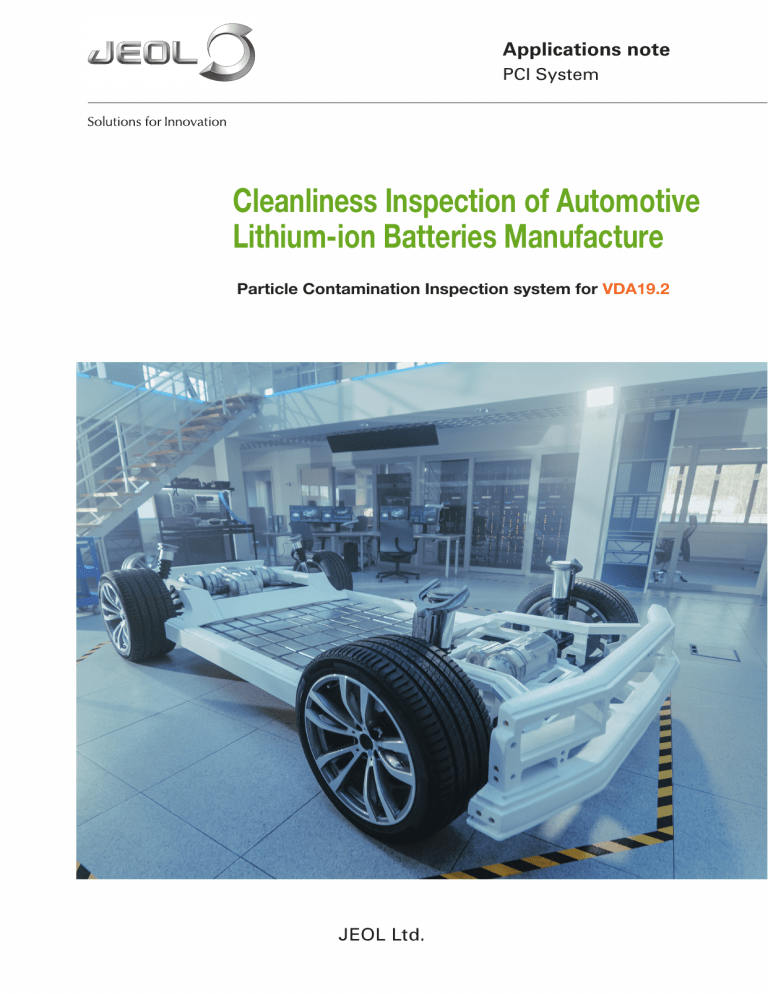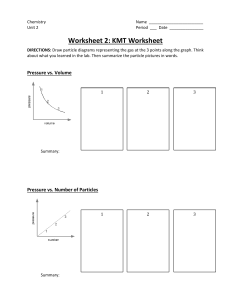
Applications note PCI System Cleanliness Inspection of Automotive Lithium-ion Batteries Manufacture Particle Contamination Inspection system for VDA19.2 Importance of cleanliness inspection of the automotive lithium-ion batteries manufacture Is the cleanliness of the assembly areas under control? Critical particulate contamination existing in assembly areas can cause product defects. For example, metallic particle contaminants mixing at the assembly areas of lithium-ion batteries (LIBs) may induce short circuits in the final products causing them to fail or as a worse case, ignite. Inspection for particulate contamination is recommended to comply with the standard called VDA 19.2 for Technical Cleanliness in assembly. Complying with this standard can improve product safety, yield and the reduction of recalled products. The standard for the cleanliness in assembly: VDA19.2 ISO16232 is the international standard for the cleanliness control of automotive components. ISO16232 is based on VDA 19 part 1 (VDA 19.1), which is the cleanliness inspection method advocated by the association of the German automotive industry (VDA). VDA 19.1 describes the requirements for determining particulate contamination on functionally relevant automotive components. For system components which cannot be cleaned after assembly, cleanliness inspection using VDA 19 part 2 (VDA19.2) is recommended. This guideline for Technical Cleanliness in assembly is designed to help protect against the entry of critical contamination via the environment during production. In automotive LIB assembly areas, the inspection of the manufacturing environment to comply with VDA19.2 should be applied. 1 Particle Contamination Inspection system JEOL’s Particle Contamination Inspection System Inspection system complying with VDA19.2 Advantages of Particle Contamination Inspection System (PCI) The PCI System uses a Scanning Electron Microscope (SEM) equipped with an Energy Dispersive X-ray Spectrometer (EDS) to analyze particles for size, shape and elemental composition. PCI offers several advantages over optical microscope methods. The system is automated and can detect smaller (sub-micron) particles versus optical methods. Not only is size and shape information determined but also the elemental composition. The PCI System can determine critical particulate contamination in LIB assembly areas for ensuring VDA 19.2 compliance. PCI Optical Microscope Detectable metallic particle size > 0.1 µm > 2 µm Elemental composition Possible Impossible Automation Multiple Single Automated particle count and identification system Particles are automatically identified from the SEM images and detected particles are analyzed by EDS. The particles can be classified by size, shape and elemental composition. It is possible to screen for only metallic particles which are a critical contaminant in LIBs. Image capture Particle identification Elemental analysis result of the particle 100 µm Results 100 µm 100 µm 5 ≦ X<15 15 ≦ X<25 25 ≦ X<50 50 ≦ X<100 100 ≦ X<150 150 ≦ X<200 Aluminium ■ 16 0 3 7 2 0 Copper alloy ■ 2 7 11 8 1 1 28 16 26 38 0 0 Tin 0 0 1 0 0 0 Particle Size [μm] Total Iron steel ■ ■ 46 23 41 53 3 1 Easy management of the results Results can be output in Microsoft® Excel®. Flexible management of the reporting, such as Illig value (sedimentation count), can be performed in accordance with your operation. ■ Areas to inspect Area 1 Area 5 ■ Example of history management of Illig values Area 2 Area 6 Area 3 Area 7 Area 8 Area 4 Area 9 ■ Inspection results of each area DATE 11/1 11/2 11/3 11/4 11/5 11/6 11/7 11/8 11/9 Area1 388 452 346 398 854 686 330 284 152 Area2 103 122 118 154 328 292 210 162 115 Area3 111 114 131 111 282 227 187 118 125 Area4 137 125 185 128 134 143 180 127 103 Area5 109 130 112 72 142 137 97 124 107 Event Illig value ■ X ≧ 500 Area 1 Area 5 Area 2 Area 3 Area 4 x ≧ 500 200 ≦ x <500 x < 200 Area 6 Area 7 Area 8 ・ ・ ・ Repair in Area 1 ■ 200 ≦ X<500 ■ X<200 With the history of Illig values, trends such as an increase in the Illig values after an event, and the area affected by the event can be determined. Area 9 Particle Contamination Inspection system 2 Workflow of cleanliness inspection PCI System enables an easy daily routine for Cleanliness Inspection 1 Criteria/ condition setting ・Specify inspection regions, target particles ・Determine criteria of Illig value. ・Set inspection conditions according to the target particles. ・This work is only necessary for the initial setup. Area 2 Area 1 Area 5 2 Area 7 Area 2 Area 1 Collect particles Data Acquisition Area 3 Area 8 Area 9 ・Prepare samples by collecting the sedimented particles on filter or tape. Sample preparation 3 Area 6 Area 4 Place on holder Conductive treatment if neededArea 6 Area 7 Set to the AreaPCI System 8 Area 9 ・Particle analysis (identification and classification of particles) is performed on multiple regions automatically. ■ Area 5 Area 4 Area 3 Fully-automated analysis workflow Particle identification Sedimented particles can be identified by their brightness difference compared to the substrate. Image capture Particles Frequency Substrate sedimented particles Field of View movement After the particle analysis of one field, the system moves to the next. View of interest Sample Measured region 3 Particle Contamination Inspection system Brightness Brightness histogram Elemental analysis Elemental analysis is performed for each identified particle. The particles are classified by the analysis result. Intensity Intensity Intensity Substrate Particle identification Fe Fe Fe X-ray energy [keV] X-ray energy [keV] X-ray energy [keV] 4 Analysis/ Confirmation ・PCI system makes it possible to relate the inspected area and the analysis results. ・The particles are classified for each size in compliance with ISO16232/VDA19.1. ・The Illig value is calculated from the results of the size classification to show the contamination grades on a map. ・It’s possible to filter the results to report only metallic particles. ■ Example Area of the size classification and Illig values at each inspected area Area 2 Area Size class / Size [μm] 1 Sampling area Illig Value Sampling Time [h] Measurement area [cm²] Total Area01 220.8 168 12.56 Area02 655.0 168 Area03 88.6 Area04 Area05 B C 5 ≦ X<15 15 ≦ X<25 46410 40546 4180 12.56 52282 38038 10032 168 12.56 23331 19016 382.5 168 12.56 52928 879.1 168 12.56 61023 ■ Example D E Area 1254 5 418 12 0 2926 1254 Area 6 32 0 3614 538 163 6 41785 8778 1672 655 50160 6270 3344 1072 H I J K Area 7 0 Area 80 0 0 0 38 0 0 0 0 0 162 15 0 0 0 0 0 0 Legend Color Illig value ■ x ≧ 500 ■ 200 ≦ x <500 ■ x < 200 Area 1 Area 5 Reporting G 25 ≦ X<50 50 ≦ X<100 100 ≦ X<150 150 ≦ X<200 200 ≦ X<400 400 ≦ X<600 600 ≦ X<1000 1000 ≦ X 0 0 0 Area 09 0 0 of the contamination map The contamination map can be made by color from the Illig values. 5 F 3 Area 4 Area 2 Area 6 Area 3 Area 7 Area 8 Area 4 Area 9 ・The report shows the results including the contamination map in various formats. ■ Example report x ≧ 500 200 ≦ x <500 x < 200 Particle Contamination Inspection system 4 Features of PCI System Functions and attachments to easily perform routine work ■ Automation and intuitive GUI PCI system includes a variety of automated functions to ensure that even novice users can operate the system easily with only a minimum of buttons displayed within the graphical user interface. SEM GUI with an optical image*1 The step-by-step routine “Sample Exchange Navi” will guide users through the sample insertion and microscope setup steps ending in an suitable SEM image. ■ Offline Data Processing Software*1 Offline Data Processing Software is available to view and review inspection data and create reports from another PC. This frees up the PCI System for additional testing streamlining workflow and productivity. ■ Large-area Stage and Large Specimen Holder Dedicated holder for filter *1 Inspect multiple filters with the large, fully-motorized stage. For example, 6 filters (47 mm diameter) can be mounted simultaneously using a dedicated holder. Automated inspections can be performed at night, increasing inspection throughput and system availability. Fits 6 filters(47 mm-diameter) ■ Carbon Coater JEOL recommends using the integrated low vacuum mode in the PCI system or to coat the samples with carbon when analyzing samples on non-conductive filters or substrates or for inspecting non-conductive particles. The JEOL Carbon Coater is a sample preparation instrument that evaporates carbon to create a conductive thin film on the sample surface. Carbon Coater*1 EC-32010CC *1: optional 5 Particle Contamination Inspection system Microscope line-up for the inspection JEOL Scanning Electron Microscopes ideal for this inspection ■ JSM-IT700HR ■ JSM-IT510 ( LaB6 ) This model uses a high-resolution Schottky field-emission electron gun. The stable emission and long lifetime of this emitter enables reproducible results and un-interrupted operation for years without gun exchange. This model can be equipped with an economically friendly a longer lifetime LaB6 electron gun. Filaments can be exchanged by users. ■ Specifications JSM-IT700HR JSM-IT510 (LaB6) Electron gun Schottky field emission (lifetime >25,000 hrs) LaB6 electron gun (LaB6 lifetime >500 hours) Resolution High vacuum mode:1.0 nm@20 kV 3.0 nm@1 kV Low vacuum mode: 1.8 nm@15 kV For analysis : 3.0 nm@15 kV, 3 nA High vacuum mode: 3.0 nm@30 kV 15.0 nm@1 kV Low vacuum mode: 4.0 nm@30 kV Maximum specimen size 200 mm diameter 200 mm diameter EDS Detectors (elemental analysis) JEOL EDS Detectors in different sizes available (60 mm² recommended), fully hard- and software-integrated ■ JEOL benefits ・“One-stop shop”: Complete system by one manufacturer (SEM, EDS, Software, Holder, Coating) ・Dedicated development team for particle analysis to ensure excellent customer support ・Full bandwidth of emitters to ensure cost-friendly solutions for all budgets ・Easy installation – no water or nitrogen needed! ・Dedicated to particle analysis – yet ready to be used for other SEM purposes (quality control,…) ・Close collaboration with existing customers – Customer feedback ensures future optimizations Microsoft and Excel are registered trademarks or trademarks of Microsoft Corporation in the United States and/or other countries. Particle Contamination Inspection system 6 No.0201B338C(Bn)





